
Rough draft for the Dauntless
Northrop is rarely associated with US Naval aviation, albeit being one of the most famous and innovative aviation company in history. Innovation was its trademark, and its contribution to the Navy during WW2 has been tremendous for a single reason. In 1933, Jack Northrop's firm was a small subsidiary of Douglas aircraft corp with just a few prototypes and civilian planes to its credit. Its first solid contract for the Navy was indeed in 1935 the BT, a dive bomber characterized by... perforated air brakes. With them, controlled dive and accurate bombing was possible. Despite a small production (only 55), the Northrop BT was the direct inspiration by its mother company -Douglas- to develop the mass-produced SBD Dauntless that turned the tables at Midway and altered the course of the war in the pacific...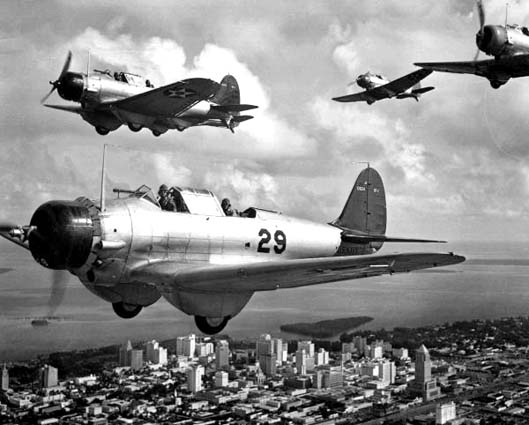
U.S. Navy dive bombers of NAS Miami, Florida n flight, October 1941.[/caption]
About Northrop
Jack Northrop's first company was called Avion Corporation in 1928. It was absorbed in 1929 by the United Aircraft and Transport Corporation, as a subsidiary and renamed "Northrop Aircraft Corporation". It moved first to to Kansas in 1931, and later Jack and Donald Douglas created "Northrop Corporation" in El Segundo, California. With a blessed weather, the company soon launched a serie of innovative single-engine passenger planes, the Alpha, Beta and Gamma. Labor difficulties led to its dissolution by Douglas in 1937 and it became as simple division Douglas Aircraft.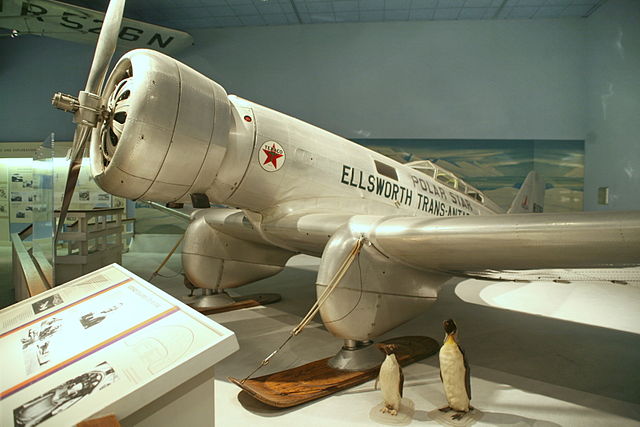
Northrop 2B Gamma Polar Star
In between, Northrop started to compete in Army Air Force and Navy programs. Its first attempt was the Northrop YA-13, a prototype of attack aircraft derived from the Gamma, evaluated but rejected by the USAAF. Improved, it became the Northrop A-17, which this time met success from 1934 (first flight), with 411 produced, in large part for export. Douglas liked the design, which became its A-33. Later in 1940, it led to a short production of its only floatplane, the Northrop N-3PB. In parallel, the company competed for the Navy contract which searched for a modern monoplane dive bomber.
Development of the BT
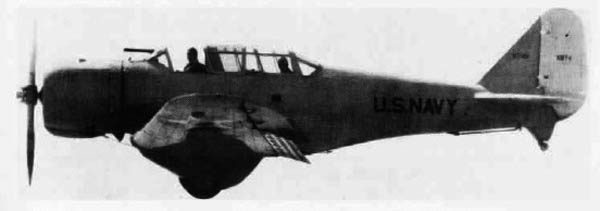
Initial XBT-1 in test flight, 1935
At the end of 1934, the Bureau of Aeronautics (BuAer) of the US Navy, published a specification for a design called “scout bombers”. Its abbreviation was SB, and another torpedo bomber at the same time, monoplanes or biplanes as the Navy was not completely decided yet. Eight companies competed. A total of ten projects were examined divided equally between monoplanes and biplanes. Northrop answered with its XSB prototype, powered by a 14-cylinder Pratt & Whitney XR-1535-66 700 hp (520 kW). It was a double star engine. The prototype also had retractable landing gear, rearward in large prominent fairings under the wings. But as the model was supposed to dive bombing, Northrop engineers came up with an ace of their sleeves: Tad two-piece perforated flaps (opening up and down) better known as "nose-down brakes". These perforated flaps were invented to eliminate unstable oscillations (“buffeting”) of tail during these nose-down maneuvers. This really was a breakthrough as its ensured the best accuracy possible. The plane did not became erratic at the most critical moment. The Navy was much impressed, but found the bird underpowered.
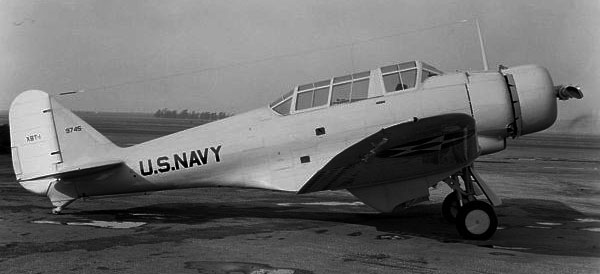
Northrop XBT-1, December 1936
Northrop therefore developed their next version called the XBT-1. It was fitted with a 750 hp (560 kW) R-1535 Pratt & Whitney double star engine. Again, it was tested and proved superior in many areas so the Navy was content with a few production and service modifications proper to navy use. Thanks to the new engine, the XBT had a reserve of power allowing some extra load. However in 1935-36, both a protective armor for the pilot's neck or self-obturating tanks were not asked for. In 1936 the XBT-1 was inspected a last time with the modification asked by the Navy and received the greenlight for production once procured the new Pratt & Whitney engine R-1535-94. It was capable of delivering 825 hp (615 kW). The other last requirement was a new tail wheel.
Meantime, Northrop tested a BT-1 modified with a fixed tricycle landing gear. It was tested by the navy and made the first tricycle landing on an aircraft carrier ever. however it was not accepted. By September 1936 at last, the pre-production BT-1 was inspected and followed by an order for 54 BT-1s. Despite its innovations and better engine, the BT-1 proved however disappointing in operations. The Navy nevertheless had supporters for Northrop's design and ordered modifications which ended with XBT-25.
From the BT-1 to the Dauntless
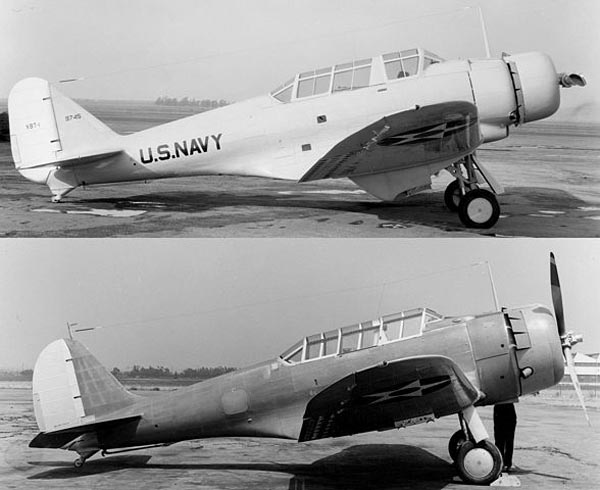
Comparison between the XBT-1 and XBT-2
The XBT-25 was a modified BT-14 in 1937, and the 54th modified production BT-1. It incorporated a new landing gear, which retracted laterally inside wings recesses, a far more conventional solution. The elimination of the massive fairings supposed to improved a lot the aircraft's flight characteristics, speed and handling. But Northrop went further and gave it fixed-slot leading edge slats, a redesigned canopy (with straight framing, no longer oblique) and above all the 800 hp (600 kW) Wright XR-1820-32 star engine. It was renamed XBT-2, and the prototype first flew on April 25, 1938. Still, it had bad flight characteristics, beyond what was expected. Alas, the Navy ordered the XBT-2 to be tested at NACA's Langley Research Center in Virginia. A series of wind tunnel tests were performed, at the conclusion of which, it was sent back to Northrop with a set of recommendation, leading to a complete overhaul of the design.

NACA's tests of the XBT-2
In late 1938, the modified XBT-2 went through a new serie of company tests, and Navy tests, which were successful. The Navy placed a new order, this time for 144 BT-2s, now far away from the BT-15. In 1939 since Northrop was integrated into Douglas, the BT-2 became under the new navy nomenclature "Douglas SBD-1", while a host of modifications during production generated for the next batch of 87 aircraft, the SBD-2. Jack Northrop left his company and created a new one under his name, "Northrop Aircraft", while the facility responsible of the SBD was now simply called the El Segundo division of Douglas, in California. The name "Dauntless" was not official. Like many other names it was chosen after a vote in the Navy during the war as a better way to identify these, rather than more obscure acronym.
Design
The BT-1 looked modern in 1935, with its cantilever wing (not foldable), nice lines and dynamic windshield cockpit design. The very large, prominent wheeltrain fairings looked odd however, and that solution was never repeated. It had a crew of two, the pilot and gunner at the rear. The fuseage measured 31 ft 8 in (9.65 m) for a wingspan of 41 ft 6 in (12.65 m), a total height on the tarmac of 9 ft 11 in (3.02 m) and a total wing area of 319 sq ft (29.6 m2).Its Empty weight was 4,606 lb (2,094 kg), and Maximal takeoff weight 7,197 lb (3,271 kg).
The BT-1 (production version), relied on the Pratt & Whitney R-1535-94 Twin Wasp Junior, double row (radial) and air-cooled. It developed 825 hp (615 kW), which at the time was respectable, but by 1942 standard, it was underpowered. Its Performances reflected this, with a top speed of 193 knots (as referred in the Navy) or 222 mph, 357 km/h, at 9,500 ft (2,900 m). Its cruise speed was 167 knots (192 mph, 309 km/h). Its range was rounded at 1,000 nmi (1,150 mi, 1,852 km) at this cruise speed of 300 kph. Its service ceiling was 25,300 ft (7,710 m), but reached with an anemic rate of climb of 1,270 ft/min (6.5 m/s).
Its armament comprised a single .50 in (12.7 mm) Browning M2HB heavy machine gun mounted in the nose, left side, and a single .30 in (7.62 mm) browning M1919A4 machine gun mounted on a railing aft of the cockpit for the gunner. It was folded down during flight and retracted to point the gun outwards as the aft glass tail was folded up and backwards. As a dive bomber, the BT-1 carried a 1,000 lb (454 kg) bomb under the fuselage's belly, mated on a launching fork, allowing it to clear the propeller. The BT-1 was seen also with standard underwing rack, probably for two 116 lb (52.6 kg) Mk IV bombs (one under each wing).
Variants
BT1S: After the XBT-1 and the 54 production BT-1s, the company tested the BT-1S. It was BuNo 0643 fitted with a fixed tricycle undercarriage. Unfortunately the prototype was badly damaged in a crash, on 6 February 1939, putting an end to the experimentation. It was returned to Douglas, repaired and converted to a standard BT-1.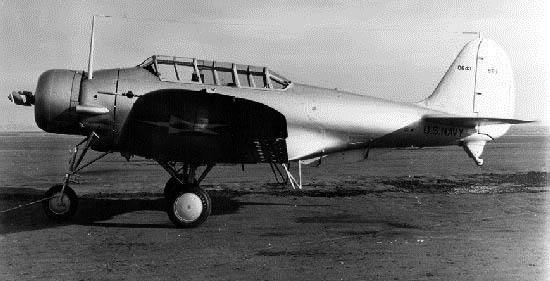
BT-1S showing its tricycle undercarriage
XBT-2: This was a BT-1 receiving a fully retractable landing gear to reduced drag, followed by many other modifications. The landing gear folded laterally into recessed wheel wells. In addition, it had leading edge slots and a redesigned canopy. The biggest change was its better engine, the 800 hp (600 kW; 810 PS) Wright XR-1820-32 radial. This XBT-2 first flew on 25 April 1938. Testings were so successful that the Navy placed an order for 144 aircraft. But by that time, in 1937, Douglas had taken over northrop, which became its local division in California, not because Douglas had a greater manufacturing capacity. These were produced at Northrop, which plant underwent a radical upsizing. In 1939 indeed, its designation was changed to SBD-1, while the second half of the batch, 87 planes, were modified and completed as the SBD-2. But until the, what became the famous Dauntless was known as the Northrop BT-2.
The Japanese BT1: Last derivative, the Douglas DB-19 was former BuNo 0643 BT-1S that we saw above, which was modified as the DB-19. It was tested by... the Imperial Japanese Navy under the name of DXD1 (a designation meaning "Douglas Navy Experimental Type D Attack Aircraft"). No doubt it was fruitful for Japanese engineers at the time.
Operational History
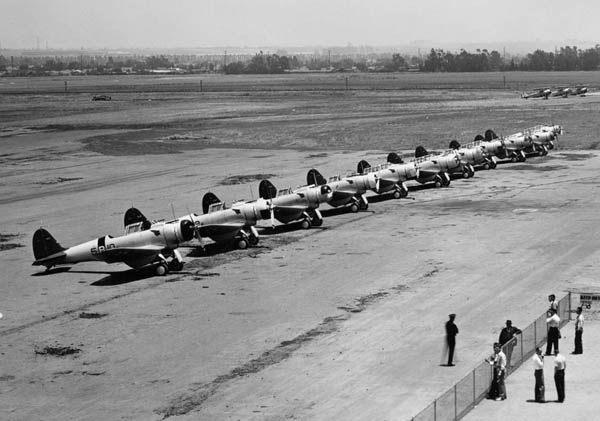
Northrop BT-1s of VB-5 lined up in 1939
The U.S. Navy 54 BT-1s entered service during 1938. They served on USS Yorktown and Enterprise. They were not popular, having poor handling characteristics notably at low speeds, making them unsuitable to land on an aircraft carrier. In flight also, it was also prone to unexpected rolls and a number of these crashed during regular flights, when pilots tried their luck in hazardous manoeuvers. The Vindicator was preferred, and from late 1940 it was phased out to the new SBD-1 and SBD-2, lightyears above in any directions. Despite being retired from frontline units, the Northrop BT-1s went to serve with the USMC and the remainder in various coastal Naval Air Bases. Among the last in service were planes from NAS Pensacola in 1942. The same year they were declared "limited standard" and retired due to the lack of spare parts until 1943. BT-1s nevertheless took part in their prewar livery in the Technicolor "Dive Bomber" (1941) starring Errol Flynn, together with Vindicators, Helldivers (biplanes) and Devastators.
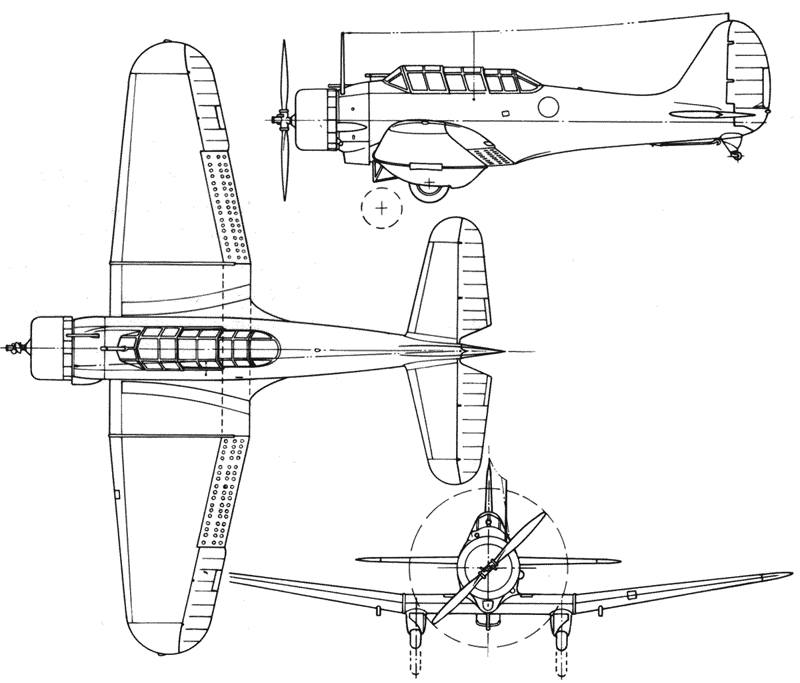
Specifications BT-1 | |
| Dimensions*: | 9.65 x 12.65 x 3.02m (32 x 41 x 9 ft) |
| Weight (Light): | 2,094 kgs (4,606 lb) |
| Weight (Max take-off): | 3,271 kg (7,197 lb) |
| Propulsion: | Pratt & Whitney R-1535-94 Twin Wasp Jr |
| Performances: | 825 hp (615 kW), 357 km/h (222 mph) |
| Range: | 1,000 nmi (1,150 mi, 1,852 km) |
| Armament - MGs: | 1x 0.5 in, 1x 0.3 in |
| Armament - Bombs: | 1,000 lb (454 kg) under fuselage, 2x 116 lb (52.6 kgs) under wings |
Read More/Src
warbirdsresourcegroup.orghistomin.com
aviastar.org
flickr.com/
historyofwar.org/
youtube.com/
Northrop_BT
en.wikipedia.org northrop
airvectors.net
Model kits: scalemates.com
Northrop BT-1, Phil H. Listemann 2008, Philedition
Bowers, Peter M. United States Navy Aircraft since 1911. Annapolis, MD: Naval Institute Press, 1990
Brazelton, David. The Douglas SBD Dauntless, Aircraft in Profile 196. Leatherhead, Surrey Profile Publications Ltd., 1967
Drendel, Lou. U.S. Navy Carrier Bombers of World War II. Carrollton, TX: Squadron/Signal Publications, Inc., 1987
Gunston, Bill. The Illustrated History of McDonnell Douglas Aircraft: From Cloudster to Boeing. London: Osprey Publishing, 1999.
Kinzey, Bert. SBD Dauntless in Detail & Scale, D&S Vol.48. Carrollton, TX: Squadron/Signal Publications, Inc., 1996.
Listemann, Phil. Northrop BT-1 (Allied Wings No.3). France: www.raf-in-combat.com, 2008.
Swanborough, Gordon and Peter M. Bowers. United States Navy Aircraft since 1911. London: Putnam, Second edition, 1976.
Illustrations:

BT-1 if VB-6 (USS Enterprise), 1938
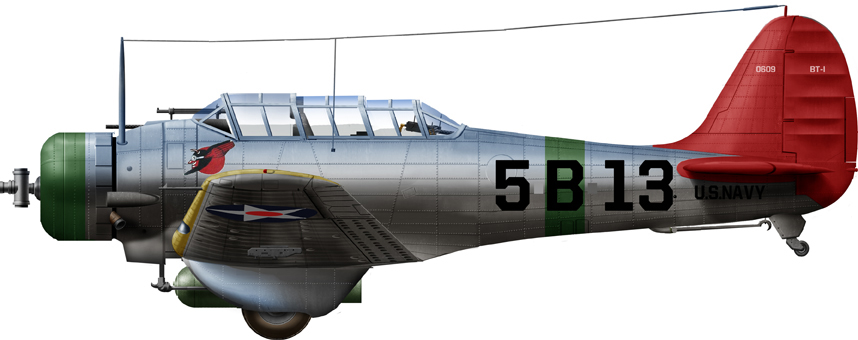
BT-1 of VB-5 (USS Yorktown), 1938
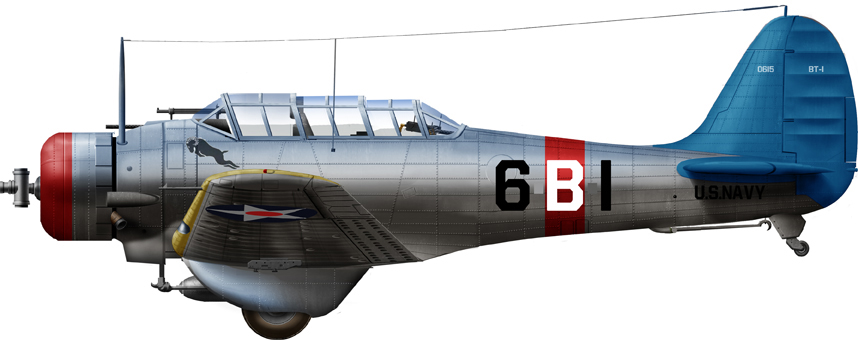
BT-1 VB-6, CV6 (USS Enterprise) 1939
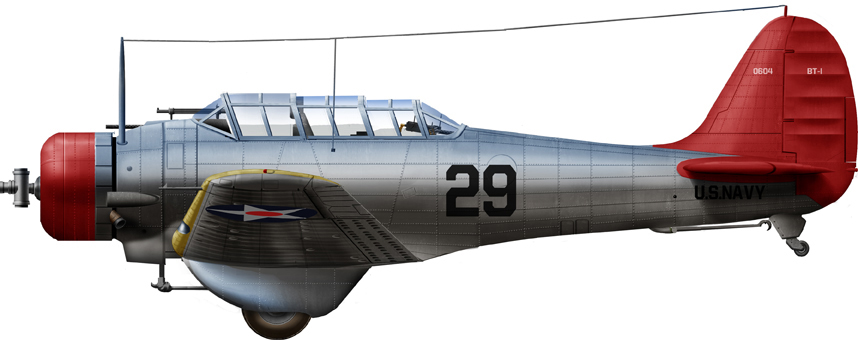
BT-1, NAS Miami, in 1941
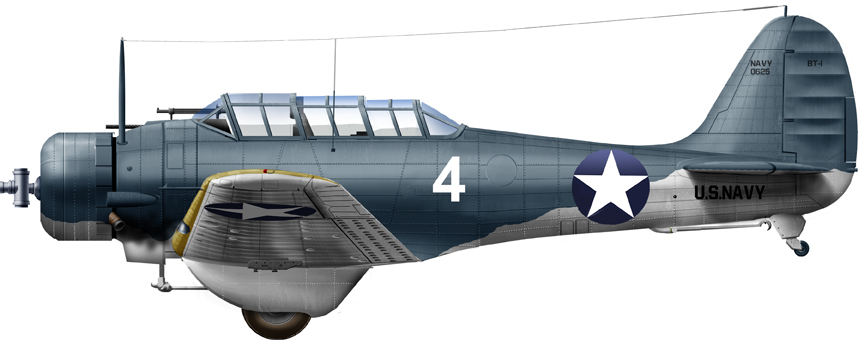
BT-1 from VN-5, NAS Pensacola, 1942
Photos:




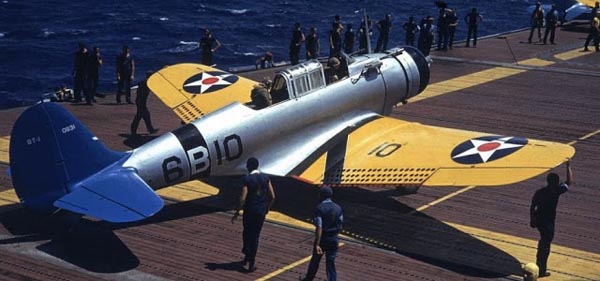
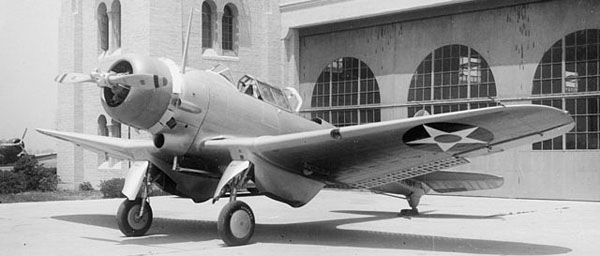

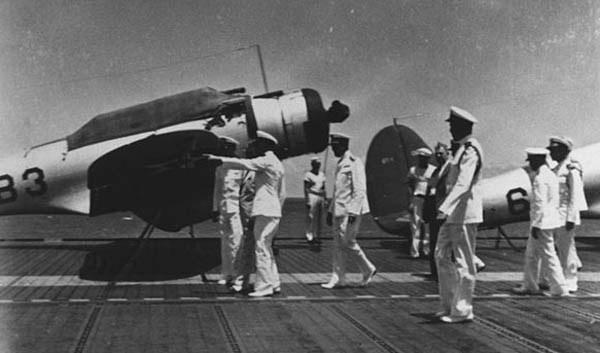
- Lohner E (1913)
- Macchi M3 (1916)
- Macchi M5 (1918)
- Ansaldo ISVA (1918)
- Sopwith Baby (1916)
- Short 184 (1916)
- Fairey Campania (1917)
- Sopwith Cuckoo (1917)
- Felixstowe F.2 (1917)
- Friedrichshafen FF 33 (1916)
- Albatros W4 (1916)
- Albatros W8 (1918)
- Hanriot HD.2
- Grigorovitch M5
- IJN Farman MF.7
- IJN Yokosho Type Mo
- Yokosho Rogou Kougata (1917)
- Yokosuka Igo-Ko (1920)
- Curtiss N9 (1916)
- Aeromarine 39
- Vought VE-7
- Douglas DT (1921)
- Boeing FB.5 (1923)
- Boeing F4B (1928)
- Vought O2U/O3U Corsair (1928)
- Blackburn Blackburn (1922)
- Supermarine Seagull (1922)
- Blackburn Ripon (1926)
- Fairey IIIF (1927)
- Fairey Seal (1930)
- LGL-32 C.1 (1927)
- Caspar U1 (1921)
- Dornier Do J Wal (1922)
- Rohrbach R-III (1924)
- Mitsubishi 1MF (1923)
- Mitsubishi B1M (1923)
- Yokosuka E1Y (1923)
- Nakajima A1N (1927)
- Nakajima E2N (1927)
- Mitsubishi B2M (1927)
- Nakajima A4N (1929)
- CANT 18
WW1
✠ K.u.K. Seefliegerkorps:
 Italian Naval Aviation
Italian Naval Aviation
 RNAS
RNAS
 Marineflieger
Marineflieger
 French Naval Aviation
French Naval Aviation
 Russian Naval Aviation
Russian Naval Aviation
 IJN Air Service
IJN Air Service
 USA
USA
Interwar
 Interwar US
Interwar US
 Interwar Britain
Interwar Britain
 Interwar France
Interwar France
 Interwar Germany
Interwar Germany
 Interwar Japan
Interwar Japan
 Interwar Italy
Interwar Italy
- Curtiss SOC seagull (1934)
- Grumman FF (1931)
- Curtiss F11C Goshawk (1932)
- Grumman F2F (1933)
- Grumman F3F (1935)
- Northrop BT-1 (1935)
- Grumman J2F Duck (1936)
- Consolidated PBY Catalina (1935)
- Brewster/NAF SBN-1 (1936)
- Curtiss SBC Helldiver (1936)
- Vought SB2U Vindicator (1936)
- Brewster F2A Buffalo (1937)
- Douglas TBD Devastator (1937)
- Vought Kingfisher (1938)
- Curtiss SO3C Seamew (1939)
- Douglas SBD Dauntless (1939)
- Grumman F4F Wildcat (1940)
- F4U Corsair (NE) (1940)
- Brewster SB2A Buccaneer (1941)
- Grumman TBF/TBM Avenger (1941)
- Consolidated TBY Sea Wolf (1941)
- Grumman F6F Hellcat (1942)
- Curtiss SB2C Helldiver (1942)
- Curtiss SC Seahawk (1944)
- Grumman F8F Bearcat (1944)
- Ryan FR-1 Fireball (1944)
- Douglas AD-1 Skyraider (1945)
Fleet Air Arm
- Fairey Swordfish (1934)
- Blackburn Shark (1934)
- Supermarine Walrus (1936)
- Fairey Seafox (1936)
- Blackburn Skua (1937)
- Short Sunderland (1937)
- Blackburn Roc (1938)
- Fairey Albacore (1940)
- Fairey Fulmar (1940)
- Grumman Martlet (1941)
- Hawker sea Hurricane (1941)
- Brewster Bermuda (1942)
- Fairey Barracuda (1943)
- Fairey Firefly (1943)
- Grumman Tarpon (1943)
- Grumman Gannet (1943)
- Supermarine seafire (1943)
- Blackburn Firebrand (1944)
- Hawker Sea Fury (1944)
IJN aviation
- Aichi D1A "Susie" (1934)
- Mitsubishi A5M "Claude" (1935)
- Nakajima A4N (1935)
- Yokosuka B4Y "Jean" (1935)
- Mitsubishi G3M "Nell" (1935)
- Nakajima E8N "Dave" (1935)
- Kawanishi E7K "Alf" (1935)
- Nakajima B5N "Kate" (1937)
- Kawanishi H6K "Mavis" (1938)
- Aichi D3A "Val" (1940)
- Mitsubishi A6M "zeke" (1940)
- Nakajima E14Y "Glen" (1941)
- Nakajima B6N "Jill" (1941)
- Mitsubishi F1M "pete" (1941)
- Aichi E13A Reisu "Jake" (1941)
- Kawanishi E15K Shiun "Norm" (1941)
- Nakajima C6N Saiun "Myrt" (1942)
- Yokosuka D4Y "Judy" (1942)
- Kyushu Q1W Tokai "Lorna" (1944)
Luftwaffe
- Arado 196 (1937)
- Me109 T (1938)
- Blohm & Voss 138 Seedrache (1940)
Italian Aviation
- Savoia-Marchetti S.55
- IMAM Ro.43/44
- CANT Z.501 Gabbiano
- CANT Z.506 Airone
- CANT Z.508
- CANT Z.511
French Aeronavale
- GL.300 (1926-39)
- Levasseur PL.5 (1927)
- Potez 452 (1935)
- Loire 210 (1936)
- Loire 130 (1937)
- LN 401 (1938)
Soviet Naval Aviation
- Shavrov SH-2 (1928)
- Tupolev TB-1P (1931)
- Beriev MBR-2 (1930)
- Tupolev MR-6 (1933)
- Tupolev MTB-1 (1934)
- Beriev Be-2 (1936)
- Polikarpov I16 naval (1936)
- Tupolev MTB-2 (1937)
- Ilyushine DB-3T/TP (1937)
- Beriev Be-4 (1940)
-
Skoda Š-328V
R-XIII Idro
Fokker C.XI W (1934)
WW2
- De Havilland Sea Vixen
- Hawker Sea Hawk
- Supermarine Scimitar
- Blackburn Buccaneer
- Hawker Sea Harrier
- Douglas A4 Skyhawk
- Grumman F9F Panther
- Vought F8 Crusader
- McDonnell-Douglas F-4 Phantom-II
- North Am. A5 Vigilante
- TU-142
- Yak 38 forger
☢ Cold War
✧ NATO
 Fleet Air Arm
Fleet Air Arm
 US Navy
US Navy
☭ Warsaw Pact
Merch

Seafire Mark 45; HMS Pretoria Castle

Zeros vs its aversaries

Aichi D3A “Val” Junyo

Mitsubishi A5M poster

F4F wildcat

Macchi M5

SBD Dauntless Coral Sea

SBD Dauntless USS Enterprise

SBD-4 CV22